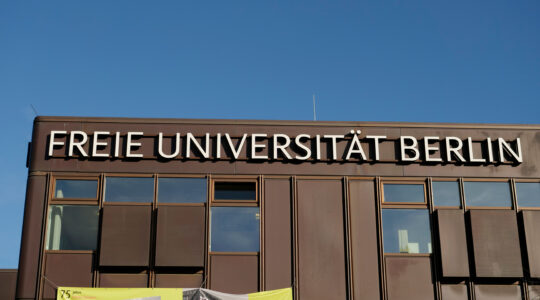
Jewish educator Alexander Abramovich is working on one way to overcome Kazakhstan’s logistics: Jewish distance-learning via the Internet. (Michael J. Jordan)
ASTANA, Kazakhstan (JTA) — For Dina Itkina, the number of times she has trekked hundreds of miles for a Jewish event are too many to count. But one time stands out in the mind of this young Jewish activist here — a journey to neighboring Uzbekistan.
Seven years ago, at the age of 17, Itkina began with a 30-hour train trip from her hometown, Kokchetav, south across the plains to Kazakhstan’s largest city, Almaty. There she met two dozen other young Jewish leaders from around the country, including a pair who had spent more than two days aboard a train from the western Caspian Sea coast. Together they piled into another train for the 12-hour overnighter to the southern city of Shymkent. Then came a one-hour bus trip to the border, an hour walk across the border and another hour ride to Tashkent, the Uzbek capital.
After three days of conference, there was the grueling return home.
“And nobody cried,” says a laughing Itkina, now 24 and director of the Jewish community center in this capital city. “You have to live here to feel the distances. But this event was a new experience, new emotions, new friends. And a lot of fun.”
It’s not only Jewish youth who are immersed in Kazakhstan’s culture of overnight train travel, tolerating odysseys that might deter all but the hardiest Westerners. This is the way of life in Kazakhstan, a country comparable in size to Western Europe, four times the size of Texas. Its population of 15 million is clustered across vast, mostly empty swaths of inhospitable desert and prairie known as steppes.
Jews comprise some 15,000 to 20,000 of the population, about half in the 13 largest urban centers and the rest in smaller towns and villages.
The geographic challenge to reach them all, and unite Jews here with a notion of a cohesive community, touches virtually every aspect of Jewish life today: welfare, religion, education, holidays, celebrations, camps, seminars and conferences. With another harsh winter just starting, the delivery of food and medical relief to the poor and elderly promises months of logistical headaches.
Even the Israeli ambassador to Kazakhstan, Ran Ichay, says that bound by his budget he must monitor if and when to travel. Prohibited from train travel for security reasons, Ichay says he must purchase two tickets on the relatively pricey domestic flights — for himself and his bodyguard.
With face time this precious, Kazakh Jewish organizations must make cold-eyed calculations.
“It’s like in a business: You want the maximum from your investment,” says the chief rabbi of Kazakhstan, Yeshaya Cohen, 37, a Chabad-Lubavitcher based in Almaty the past 14 years.
“It’s difficult because you want to be there for every Jew,” says Cohen, one of five rabbis in the country. “You make a seder in one city, then another city wants a seder, too. So you have to pick and choose. And sometimes the interest in a city of 1,000 Jews isn’t as strong as in a town with two Jews.”
Just as the size of Kazakhstan has long been a challenge, so, too, has the task of bringing Jews together.
Unlike unique, historic Jewish communities across the former Soviet Union — like the shtetl Jews of Ukraine, the Litvaks of Lithuania, the Bukharans of Uzbekistan or the Mountain Jews of Azerbaijan — the Jews of Kazakhstan are almost entirely transplants from elsewhere. Rarely was it voluntary.
Beginning in the 1930s, Jews were among the millions whom Joseph Stalin shipped into Kazakhstan, the key southern link in his dreaded network of concentration camps known as “the Gulag.” Many others were deported here as “internal exiles,” restricted to living within certain villages.
Another wave of Jews soon arrived in the second-largest Soviet republic during World War II. They were evacuated from the western front, and places like Ukraine and Belarus, as the Nazis methodically cleansed the countryside of Jews.
Torn from their family and community — and with repression palpable — many Jews assimilated and intermarried in high numbers, like elsewhere in the Soviet Union.
Since Kazakhstan’s independence in 1991, some 75,000 Jews have immigrated to Israel, Russia, Germany and beyond.
Another 30,000 may be hiding their Jewishness or simply are too far away to be reached, says Alexander Baron, the president of Mitsva, the Association of Jewish National Organizations in Kazakhstan.
“We’re still meeting people who are afraid of Stalin’s regime,” says Baron, based in Almaty.
Reaching the remote areas is particularly difficult during winter. Astana, in fact, ranks among the world’s coldest capitals. Even in March, when spring breaks in Almaty, Astana endures sub-freezing temperatures, bitter winds and sidewalks blanketed with ice.
Train travel is generally reliable — highlighted by the 12-hour Astana-Almaty express that folks here curiously nickname “the Spanish train” — but the rails are primarily between large cities.
Everywhere else, the rutted, mostly single-lane roads are prone to long bouts of snow, ice and wind. In many villages the blacktop soon dissolves into muddy, unpaved tracks.
To counter the logistics of distance, the American Jewish Joint Distribution Committee created 13 separate Hesed offices nationwide to provide food and welfare. The warm and humble operations, typically located in dilapidated apartment buildings, reached Jews in 160 towns and villages last winter.
The agency also has six “Hesed-mobiles” — vans delivering monthly bundles of food, medicine, clothes and newspapers to clients in outlying communities, some as far away as a four-hour drive. The Hesed-mobile in Almaty, Baron says, is responsible for 40 villages across the province. A driver, social worker and medic go out for three days at a time, hit maybe 15 settlements and log about 1,000 miles before returning to Almaty, loading up the van again and starting another three-day circuit.
The visits provide more than sustenance. In Karaganda, the nation’s third-largest city, a Hesed-mobile driver says his van provides a lifeline to those in near isolation.
“They’re lonely people, so of course they’re happy to see that someone cares about them,” says Leonid, 55. “They never let me leave without a tea or something.”
Chabad itself launched a “Mitsva-tank” in 1999, a “synagogue on wheels” that visited a half-dozen towns for one or two days each, says Rabbi Yehuda Kubalkin, the religious leader in Astana.
Since then, the movement relies mostly on young, enthusiastic yeshiva students who come from Israel during the High Holidays and fan out across the country. Chabad also widely distributes its newspapers, matzah and even kosher meat — via refrigerated train cars — for special occasions, says Cohen.
Then there’s the if-you-build-it-they-will-come approach: Last June, Karaganda hosted its fourth annual festival for Jewish youth from across Central Asia and Russia.
Jews within reasonable reach will come to the four functioning synagogues in Kazakhstan. On the eve of Purim earlier this year, for example, Karaganda sent a busload of some 40 Jews, most of them elderly and children, to celebrate at Kubalnik’s synagogue in Astana. It was a four-hour bus ride in the morning, several hours of festivities and a return home that night.
Not even rabbis are immune to the sense of isolation. A newly built synagogue in the eastern city of Ust Kamenogorsk welcomed a Chabad emissary last year to set up operations, but Cohen and Kubalkin say he lasted only a few months, turned off by the long overnight train trip, or two-hour flight, to his nearest colleagues in Almaty or Astana.
Distance is also an issue for providing nourishment in the form of Jewish education. In Karaganda, Jewish educator Alexander Abramovich meets twice a year with counterparts from across Kazakhstan for “teach the teachers” seminars with a visiting Israeli expert. The teachers transmit the knowledge to classes back home.
Abramovich is devising an online, distance-learning strategy that he says should bring more Jews into the process.
“It’s the ‘tradition chain,’ where Jewish traditions are passed down from one person to another, that we’re trying to re-create here,” he says.
Still, the Jews of Kazakhstan are resigned to their reality — and the distances.
“It’s a simple thing in life,” says Itkina, the young activist and communal worker. “It doesn’t matter if it’s a small country or a big country; if somebody really wants to do something, they will.”
JTA has documented Jewish history in real-time for over a century. Keep our journalism strong by joining us in supporting independent, award-winning reporting.





